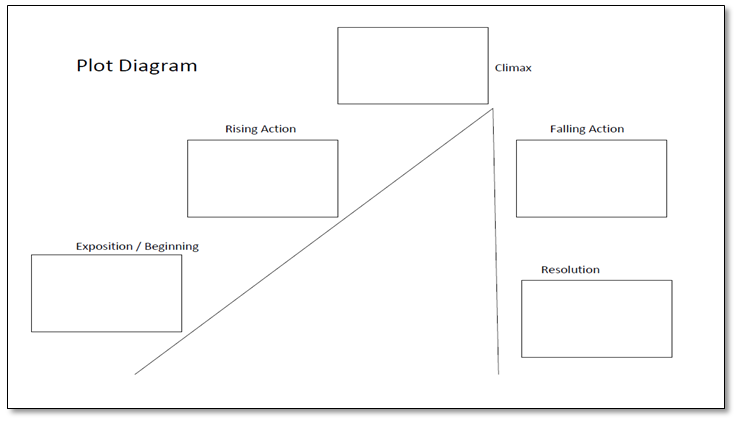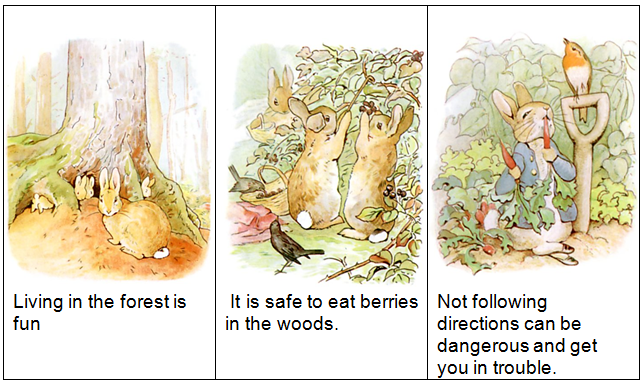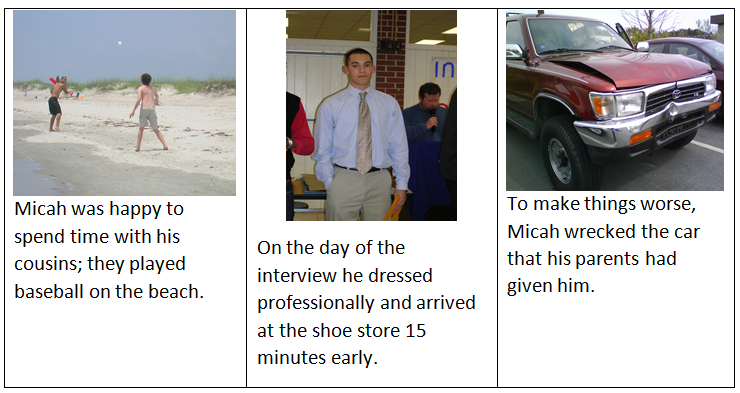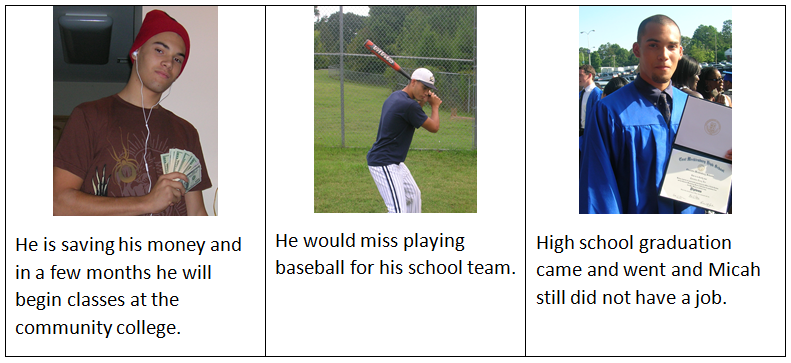Curriculum Resource Guide:Reading Literary Texts
BACK TO Curriculum Resource Guides
1a. Key Ideas and Details
What are "main ideas" and how are they taught in general education settings?
The main ideas of reading literary text are the most important points that the author is trying to make about a specific topic. Identifying and categorizing main ideas within literary text is critical to successful readers because it allows readers to prioritize information in the text to better comprehend content. Understanding the relationship between key ideas and supporting details can also lead to greater comprehension.
Common misunderstandings
Students may have difficulty determining what essential information is. Students often misinterpret details as being the main idea and need to be guided to see the author's overall point or the 'big picture'. It is also important to note that the main idea is not simply what the text is about (e.g., for example in Jack and the Beanstalk, selling the cow is a detail in the story but is not essentially related to the main idea).
Prior knowledge/skills needed (skills can be taught concurrently) In general education, the student typically will need to:
- Distinguish fiction from nonfiction
- Identify the author's key points
- Summarize text
- Comprehend text
- Identify supporting details
What is "theme" and how is it taught in general education settings?
Theme is an idea or concept central to a story and can be described in one word or short phrase (e.g. love, honesty, being polite). A theme may be represented by the actions, communications, or thoughts of a character or characters in a story/novel. A theme is not directly stated; it often appears as a lesson or message that the reader understands by making inferences.
Common misunderstandings
Main idea and theme are often confused as being the same. Although both can be related, theme is a broad topic, whereas main idea is more specific. (For example, nature may be the theme of a story; whereas the main idea is "littering is bad".
Prior knowledge/skills needed (skills can be taught concurrently) In general education, the student typically will need to:
- Use one word or short phrases to describe the story
- Determine the main ideas within a text
- Summarize text
- Comprehend text
What is "inference" and how is it taught in general education settings?
Inference is using the information gained from the text along with background knowledge to figure out something that the author doesn't explicitly share. Making inferences significantly boosts comprehension as it makes the reader draw on prior knowledge and make personal connections to the story.
Common misunderstandings
Often, being taught how to make inferences is overlooked and thought to be implicitly learned. Also, teachers often assume that all students have the same or similar prior knowledge; teachers must be diligent to provide examples and background understanding.
Prior knowledge/skills needed (skills can be taught concurrently) In general education, the student typically will need to:
- Identify clues given that help the reader determine an idea/theme/conclusion that is not explicitly stated
- Comprehend text
Why is it important to "build background knowledge"? How is it done in the general education classroom?
Background knowledge is information students already know and what they need to know in order to understand the story or content. Background knowledge can be built directly and indirectly. Direct experiences (i.e. teacher modeling, think-aloud strategies, cross-curricular activities) may effectively build relevant background knowledge. Indirect experiences (i.e., field trips, video clips, class activities, simulations) may also build background knowledge. Common misunderstandings
Many teachers assume students already know about a topic based on their age or what they should have learned in a previous grade or class. When background knowledge is not built or activated, students will lack the schema to understand new material and may not effectively learn and understand the topic or concept.
What is "summarizing" and how is it taught in general education settings?
Summarizing involves determining the essential information within a text and putting the big ideas or most important concepts of a text into one's own words. Summarizing is an important skill because it helps students prioritize information and remember the main ideas of what they have read.
Common misunderstandings
Teachers sometimes mistakenly believe that students have the ability to determine what is essential within a text. Explicit teaching is often required for students to learn this skill.
Prior knowledge/skills needed (skills can be taught concurrently) In general education, the student typically will need to:
- Comprehend text
- Determine main ideas
1b. Craft and Structure
What is "point of view" and how is it taught in general education settings?
Steps for teaching Point of View:
- Define and Explain Each Point of View:
- First person- The story is told from the perspective of a character. The narrator uses the words "I" or "my" to tell the story. The narrator may also use words like "we" and "our" to describe events in the story.
- Second person- The story is written directly to a specific character or the readers. The narrator uses the words "you" or "your" to tell the story.
- Third person objective- The story is written from the perspective of someone outside the story, or minimally from the perspective of a minor character. The narrator tells "his" or "her" story.
- Third person limited-The narrator tells "his" or "her" story and reveals one character's thoughts or feelings.
- Third person omniscient- The narrator tells "his" or "her" story and reveals more than one character's thoughts or feelings.
- Give Students Practice Identifying First, Second, and Third-Person Narration
- Stress the Differences Between Third-Person Narrations
- Give Students Practice Identifying the Narrator's Point of View
Common misunderstandings Students commonly mistake point of view for what the author thinks or a character's "opinion" about something.
Prior knowledge/skills needed (skills can be taught concurrently) In general education, the student typically will need to know:
- Identify pronouns (e.g. I, me, we, our, you, she)
- Comprehend text
What are "story elements" and how is it taught in general education settings?
Story elements are, essentially, the parts of a story. There are five main story elements: plot, character, conflict, setting and resolution. These elements develop the actions or events in the story in a logical way to enable readers to easily follow the text.
Five Essential Elements:
- Characters - the individuals the story in the story.
- Setting - the location and time period where the story takes place.
- Plot - what happens in the story and should a clear beginning, middle, and end.
- Conflict - the problem in the story. The plot in a story should be centered on the conflict.
- Resolution - the solution to the problem or conflict.
Common misunderstandings
Students often miss aspects of story elements when summarizing a text. In addition, some texts are considered inconsiderate texts and do not provide enough to allow students to fully understand all story elements and must fill in the gaps of with prior experiences and personal preferences, leading to problems with comprehension.
Prior knowledge/skills needed (skills can be taught concurrently) In general education, the student typically will need to:
- Identify details within a text
- Comprehend text
1c. Integration of Knowledge and Ideas
What is a "plot graph" and how are plot graphs used in general education settings?
A plot graph in literature is basically a map of a book or story. It includes the introduction, rising action, climax, falling action and resolution. A plot graph is also called a plot diagram. The most common graphic organizer used to analyze the plot of a text looks like this:
Taken from http://englishlinx.com/plot/ . Reprinted with permission.
For additional examples of plot diagrams, go to: http://education-portal.com/academy/lesson/what-is-a-plot-diagram-definition-examples-quiz.html\#lesson
Common misunderstandings
Similar to those in story elements as they are represented in the diagrams/maps
Prior knowledge/skills needed (skills can be taught concurrently) In general education, the student typically will need to:
- Differentiate between story features
What is "genre" and how are they taught in general education settings?
A genre is a category of literary composition determined by literary technique, tone, content or length. The most commonly taught genres are epic, tragedy, comedy, fiction, non-fiction.
Genres in Children's and Young Adult Literature
| Category: | Brief Description: |
| Picture books | Are considered a format and not a genre. They are a format in which art and text are interdependent. All genres appear in picture books. |
| Poetry and Verse | Condensed language, expression of imaginative thoughts and perceptions, often containing rhythm and other devices of sound, imagery, and figurative language. |
| Folklore | Traditional stories, myths, legends, nursery rhymes, and songs from the past. Oral tradition with no known author, passed on from generation to generation. |
| Fantasy | Stories set in places that do not exist, about people and creatures that could not exist or events that could not happen. Make-believe and imaginative worlds. |
| Science Fiction | Based on extending physical laws and scientific principles to their logical outcomes, usually futuristic. Describes worlds that are plausible and could exist someday. |
| Contemporary Realistic Fiction | Stories could happen in the real world; characters seem real; contemporary setting. |
| Historical Fiction | Stories reconstruct life in the past, using realistic actual and fictional characters, events and historical setting. |
| Biography | An account of a person's life, or part of a life history by someone else or the person him or herself. Includes autobiographies, memoirs, letters, diaries, journals. |
| Nonfiction | Informational books that explain a subject or concept using facts about the real world. |
Galda, L., Cullinan, B. E., & Sipe, L. R. (2010). Literature and the child. Belmont, CA: Wadsworth/Cengage Learning, p. 12.
2. What are some of the types of activities general educators will use to teach this skill?
2.1 Activities from General Education Resources
Determining main idea
- Read text in segments, stopping to allow students to identify the main idea. Use a graphic organizer to list main ideas and details. Full lesson plan available at http://betterlesson.com/lesson/33460/main-idea-strategies
- After reading literary text, present students with three sentences. Ask students to select the sentence that gives the main idea.
Selecting supporting details
- Reading Guides. The teacher determines the major ideas from a book and then writes questions or statements designed to guide readers through the major ideas and supporting details of the text. Guides may be phrased as statements or as questions. Initially, teachers and students work together to respond to statements or questions on the reading guides during the reading process. Teachers should monitor and support students as they work. As students gain proficiency at completing reading guides, they may design their own guides and provide support for one another. More information on guides can be found at: http://www.readingrockets.org/strategies/reading_guide/
Making inferences
- Two-Column Notes. T-notes provide students with a means of citing evidence/taking notes while listening or reading. T-notes are generally created by dividing a sheet of notebook paper in half. While listening or reading, students record evidence (e.g., record facts from the text that the author provides) in the left column. Students use the right column to make inferences, ask questions, or draw pictures to clarify their evidence. A free printable graphic organizer can be found at: http://freeology.com/graphicorgs/
- 'Using a character's actions to make inferences.' After reading the The Chenoo, a Native American Legend, students use a graphic organizer to list words and actions of the character Nolka and then use these to make an inference about Nolka1.
| Words and actions | Inference |
| She was in great fear. "Now," she thought, "my death is near; he will kill and devour me." | Nolka was courageous. |
- Combine details from text with your own knowledge.' An inference is an educated guess. The answer is not explicitly stated in the text. Students often need to combine what information is gained from the text with their own background knowledge in order to make an inference. While reading the poem I'm Nobody! Who are You?' by Emily Dickenson, use a graphic organizer similar to the one below to make inferences2.
| Line in Poem | What I Know | Inference | ||
| How dreary to be somebody!
How public, like a frog |
+ |
I know that dreary means sad and depressing. |
= |
The author thinks it would be a bad thing to be a person who has to live in the public eye. |
Summarizing
- Summarizing and Note-taking. Students must possess the ability to synthesize information in order to summarize and take notes. Details will help tell you about the main idea (Marzano, Pickering, & Pollock, 2001). Students should be reminded not to confuse a text detail with the main idea.
- During the oral reading, model using think-aloud multiple times. Include statements such as: "This detail tells me…" "The text is mostly about…" "This is a very important detail because…" "This passage talks about…"
- Post at least four sentences that all students can see. Use a think-aloud approach with the students and explain why the central ideas are key to understanding and why the others are details. It is important for students to hear your thinking.
- Explain why finding the central idea is an important skill. Show students how to record the main idea/details in a graphic organizer.
- Model and practice in small groups numerous times before students try it independently.
- There are a variety of graphic organizers that can work for this skill depending on the length of the text.
- Reading for the Gist3. While the teacher reads aloud, students write their thoughts, predictions, and/or questions in reference to the text. In effect, students are synthesizing the information and checking their understanding. Being able to synthesize information read or heard is a necessary component of summarizing. Using the picture book An Angel for Solomon Singer by Cynthia Rylant, the teacher reads aloud, stopping periodically to write her own thoughts (this can be done in a journal, in the margins of the text, or on sticky notes). The teacher shares her thinking and gives students a moment to record their own thoughts.
1, 2 Houghton Mifflin Harcourt Publishing Company (2012), Holt McDougal Literature Interactive Reader Grade 6 3Harvey & Goudvis (2007). Strategies that Work. Pp.187.
2.2 Links Across Content Areas
- Reading literary text is equally as important in language arts as it is in all other curricular areas. Once a student learns how to read, organize, understand and collect valuable information from reading text, those skills can then be utilized in all subject areas. Students often need explicit instruction in how to apply these skills to content area texts that have specialized text structures and vocabulary which can challenge comprehension. It is important that teachers in all of the content areas support the ideas and skills taught in this module. Cross-curricular activities can range from commonly used strategies to shared topics and projects.
- For example, if using context clues is a skill being taught in Reading/Language Arts, this strategy could be reinforced during science, social studies and math.
- Science: Students in the science class can use context clues to determine the meaning of vocabulary from the text.
- Math: Students can use context clues to determine which information in a math problem is necessary or extraneous to solving the problem.
- Another example of a cross-curricular activity can be done in the form of a grade level project. If the 6th grade social studies class is learning about Egypt, the following cross-content instruction can occur:
- English: Chose literature set in Egypt during language arts.
- Science: Students may research the scientific techniques and/or contributions developed in Egypt.
- Math: Students can:
- Calculate the distance from their home address to Egypt
- Develop a travel plan which would include travel cost, room and board one-way and round-trip.
- Physical Education: Students may learn an Egyptian dance or sports commonly played in Egypt.
- Music: Students may listen to music from different Egyptian cultures.
- Art: Students can work to develop a diorama, pottery, or end product representing all they have learned in their classes.
- Specifically at the high school level, teachers may collaborate to plan interdisciplinary lessons.
- For example, as students learn about the Middle Ages in European History, literary pieces such as The Canterbury Tales and others written during that time and/or set in Europe during that time period can be taught. The art and music of the era can be covered in the appropriate classes simultaneously.
3. What Connectors to the Common Core Standards are addressed in teaching "Reading Literary Texts"?
- The Core Content Connectors (CCC) are categorized into four strands: Reading at the Word Level, Habits and Dispositions, Reading Informational Texts, and Reading Literary Text. Each strand provides the CCC as well as the aligned grade-specific CCSS.
- CCCs relevant to this curriculum resource guide can be found in the Reading Literary Text strand.
- These CCCs can be accessed via the NCSC WIKI at :
https://wiki.ncscpartners.org/mediawiki/index.php/Core_Content_Connectors
| Performance Examples for Priority CCCs | |||||
| Grade 3 | |||||
| CCC | Performance Example | Essential Understandings | |||
| 3.RL.k2 Determine the central message, lesson, moral, and key details of a text read aloud or information presented in diverse media and formats, including visually, quantitatively, and orally. | Directions: Read the passage.
Excerpt from 'The Tale of Peter Rabbit' by Beatrix Potter Once upon a time there were four little Rabbits, and their names were— Flopsy, Mopsy, Cotton-tail, and Peter. They lived with their Mother in a sand-bank, underneath the root of a very big fir-tree. 'Now, my dears,' said old Mrs. Rabbit one morning, 'you may go into the fields or down the lane, but don't go into Mr. McGregor's garden: your Father had an accident there; he was put in a pie by Mrs. McGregor.' 'Now run along, and don't get into mischief. I am going out.' Then old Mrs. Rabbit took a basket and her umbrella, and went through the wood to the baker's. She bought a loaf of brown bread and five currant buns. Flopsy, Mopsy, and Cotton-tail, who were good little bunnies, went down the lane to gather blackberries. But Peter, who was very naughty, ran straight away to Mr. McGregor's garden and squeezed under the gate! First he ate some lettuces and some French beans; and then he ate some radishes; and then, feeling rather sick, he went to look for some parsley. But round the end of a cucumber frame, whom should he meet but Mr. McGregor! Mr. McGregor was on his hands and knees planting out young cabbages, but he jumped up and ran after Peter, waving a rake and calling out, 'Stop thief!' Peter was most dreadfully frightened; he rushed all over the garden, for he had forgotten the way back to the gate. He lost one of his shoes amongst the cabbages, and the other shoe amongst the potatoes.
Source: http://en.wikisource.org/wiki/The_Tale_of_Peter_Rabbit Copyright: This work is in the public domain in the United States because it was published before January 1, 1923. |
Identify the topic of a text or information presented in diverse media.
THEN
Identify a supporting detail of the topic in a text or information presented in diverse media. THEN
With prompting and support, answer simple questions about the central message, lesson, or moral of a story, fable, or folktale (i.e., After reading this story, what happened to the character? So, what did the character learn? | |||
| Grade 7 | |||||
| CCC | Performance Example | Essential Understandings | |||
| 7.RL.i2 Use two or more pieces of textual evidence to support conclusions, or summaries of text.
. |
Directions: Read the passage below.
A Bumpy Ride Bobby was bouncing up and down in his seat. "Are we there yet?" he asked his mom. He had been waiting for this all summer. He was headed to the Funtown Amusement Park. He just couldn't wait to play on all the rides and games. This year he was old enough to ride the bumper cars alone. He watched his mom and dad drive him to school every day and it seemed easy to him. The best part about bumper cars was that you can actually bump other cars without getting into trouble. When they finally made it into the amusement park, Bobby dashed straight for the bumper cars. He hopped into the first bumper car he passed and buckled his seat belt. He looked at the person in the car next to him and said, "This is going to be a bumpy ride!" 1) What is "A Bumpy Ride" mostly about?
|
Make an inference from a literary text.
THEN
Identify a conclusion from a literary text. THEN
Identify a summary of a literary text. THEN
Identify a detail to support the inference, conclusion, or summary. | |||
| Grade 11 | |||||
| CCC | Performance Example | Essential Understandings | |||
| 1112.RL.b1 Use two or more pieces of evidence to support inferences, conclusions, or summaries of the plot, purpose or theme within a text. | Directions: Read the passage below.
Life after High School Graduation Micah was an intelligent young man, he enjoyed learning about history and how to fix cars in shop class. Micah thought a lot about what he wanted to do after he graduated from high school. He would miss playing baseball for his school team. Micah wanted to attend community college but his family did not have money to pay for the classes; Micah would have to get a job and save the money himself. High school graduation came and went and Micah still did not have a job. There were not many jobs in his home town. To make things worse, Micah wrecked the car that his parents had given him. Micah thought to himself "I am the unluckiest person around!" Micah's father said "Micah, you have been looking for a job and helping out around the house every day. Your aunt and uncle are going to the beach and they have invited you to go with them. Go and have some fun!" Micah was happy to spend time with his cousins. They played baseball on the beach. Micah missed playing baseball! The trip to the beach was just what Micah needed. When Micah arrived home his father was excited. "Micah!" His father said. "The manager from the shoe store called. She reviewed your application and would like you to come in for a job interview!" "Yes! Maybe my luck is changing." Micah replied. Micah wanted to be prepared for his interview. He practiced shaking hands and saying "hello", answering mock interview questions; he even practiced selling shoes to his little sister! On the day of the interview he dressed professionally and arrived at the shoe store 15 minutes early. He really wanted this job. Micah's preparation paid off. The shoe store manager called back to offer Micah the job! Now things are going well for Micah. He loves working at the shoe store. He is saving his money and in a few months he will begin classes at the community college. Life after high school graduation is pretty good. As long as you have a plan! Listen to a summary of the story Life After High School Graduation. Read the summary. After graduating from high school Micah needs to find a job to pay for school. Micah has some hard times after high school graduation. Things eventually get better for Micah. He gets a job and saves his money. |
Identify a summary of the plot of the literary text.
THEN
Find evidence for a conclusion from a provided text. THEN
Find evidence for a selected inference from a provided text. THEN
Identify the theme of a literary text. THEN
Identify details to support the plot or theme of the text. | |||
4. What are some additional activities that can promote use of these academic concepts in real world contexts?
Here are some suggestions from specific grade level texts for promoting use of academic concepts:
| Story | Real Life Application | |
| K-2 | The Gingerbread Man by Carole Moore |
|
| K-2 | The Very Hungry Caterpillar by Eric Carle |
|
| 3-5 | Esperanza Rising
by Pam Munoz Ryan |
|
| 3-5 | Salt in His Shoes by Deloris Jordan |
|
| 6-8 | A Single Shard
by Linda Sue Park |
|
| 6-8 | The Outsiders by S.E. Hinton |
|
| 9-12 | Marcelo in the Real World by Francisco X. Stork |
|
| 9-12 | The Great Gatsby by F. Scott Fitzgerald |
|
5. How can I further promote College and Career Readiness when teaching "Reading Literary Texts"?
Ideas for Promoting Career/ College Ready Outcomes
Communicative competence: Skills related to increasing overall communicative competence include an increase in the student's vocabulary that is relevant to daily life. Narrative text include many opportunities for students to practice identifying the feelings of others as well as their own. Narrative text may provide opportunities for students to develop skills to talk about age appropriate but difficult topics (e.g. racial tension, sexuality, stealing, and homelessness). Through the practice of retelling narrative text, students will have opportunities to generalize these skills to effectively and accurately tell/retell their own story.
Fluency in reading, writing, and math: When students are provided with repeated exposure to literary text, they may demonstrate increased fluency in reading, writing and math. Students are presented with opportunities to comprehend information presented via text, text read aloud, media, or a speaker. Students may demonstrate increased fluency in math with increased opportunities to comprehend information presented visually, such as illustrations found in stories, books, and digital format. Students may also increase their ability to comprehend more complex stories/texts and develop inferential comprehension. Skill development may also improve the use of new vocabulary including descriptive language and relevant summarization.
Age appropriate social skills: There are many age appropriate social skills to be gained via instruction using literary text. Students increase their friendship skills, conflict resolution, and family relationships. Student may also learn to respect cultural differences. Reciprocal communication may be enhanced by knowledge and understanding of world events/global awareness. Appropriate social skills are often the topic of literary text at all ages. Social narratives may be an effective strategy for teaching appropriate social skills. More information about using social narratives can be found at: http://www.ttacnews.vcu.edu/2011/09/teaching-social-skills-through-social-narratives-another-evidence-based-practice/
Independent work behaviors: Students' independent work behaviors may be enhanced by students' increased abilities to: read independently, answer questions and provide details, both personal and work-related. Most jobs require students to follow a sequence of steps. In addition, students can increase their independent work behaviors and success by using graphic organizers to compartmentalize work task. Social narratives may also be appropriate when teaching independent work behaviors.
Skills in accessing support systems: Reading literary texts, regardless of how it is presented, may help develop problem solving skills. Often, identifying a problem and finding a solution is modeled within literary texts. Students may be able to learn from characters in text. They may also be able to make connections between situations in text to situations in their own lives. Realistic fiction is a specific genre that may be helpful when teaching students to access support systems.
6. How do I make instruction on "Reading Literary Texts" accessible to ALL the students I teach?
6.1 Teach Prerequisites Concurrently While Teaching Skills Related to Reading Literary Texts: Remember that students can continue to learn basic literacy skills in the context of this grade level content.
Basic literacy skills that can be worked on as a part of a lesson relating to literary text:
- Answering literal recall questions
- Making inferences that are relevant and meaningful, possible but not related to written text
- Determining the main idea or the most important events in personally relevant stories (e.g., auto-biographies)
- Differentiating between nonfiction and fiction texts
- Identifying author's purpose
- Vocabulary acquisition
- Using visual cues to find important information (e.g., highlighting or added visuals)
6.2 Incorporate Universal Design for Learning (UDL) in Planning and Provide for Additional Differentiated Instruction when Teaching Reading Literary Texts
Some examples of options for teaching vocabulary and acquisition skills to students who may present instructional challenges due to:
| Sensory Differences (such as Blindness, Visual Impairment, Deafness, or Deaf/Blindness) | Physical Disability or Motor Differences (such as weakness or motor planning difficulty) | Extremely limited evidence of experience/ skill or motivation/ attention | Limited or no speech | |
| Representation | Reduce glare, increase contrast between materials, manipulatives, and ensure that the size of the materials and print are appropriate for the student's vision; raised text or Braille; use objects and images to represent vocabulary words and answers to questions; Some students with visual impairments will benefit from light boxes to increase contrast between objects and background and/or other devices to enlarge or magnify print and materials. Students with hearing impairments may benefit from amplification systems or assistive listening devices; add sound effects when appropriate (e.g., sound of a whale, busy city streets, a tornado); preteach basic concepts using objects; color photos; interactive whiteboards can be used during instruction. | Student scans an array of possible options and use a switch to select the correct vocabulary word or answer to questions; use computer that can be manipulated with switch; place response options on a slant board or eye gaze board; create a vocabulary matching exercise in the classroom that the student can walk or ride on in wheelchair to find the matching words and meanings (this can include picture clues or objects).
Place images, graphs, and excerpts from upcoming course content in the middle of a poster paper and ask students to add information/details around it as class progresses. Hang images around the room that relate to the topic and discuss them prior to reading. |
Use motivating objects (e.g., pizza, coloring markers in a box, piece of a Lego set; older students can use modeling clay, paper machete, create collage posters, or other visual representations) to incorporate key vocabulary and details from text; incorporate technology including computer representations, videos, animations, and talking avatar; allow students to self-select stories to read; use You Tube that is related to instruction; Smartboard can be used during instruction. Reciprocal peer modeling and small group work with designated tasks. Allow opportunities for repetition and practice of previously introduced material.
|
Have student use online dictionary to pronounce and define words; use online visual dictionary to increase vocabulary; students can use one to one correspondence to match words or objects with definitions; preteach vocabulary( or characters, and setting) using AAC devices; highlight vocabulary words within the context of the print, keep to one vocabulary word per page and keep an AAC device with matching word with the text (e.g. using a list of character names and corresponding pictures, have student match the name card with the correct character); use an iPad during instruction.
\*Suggestions from other columns may be applicable here.
|
| Expression | Capitalize on sense of touch through the systematic use of manipulatives throughout the lesson. Pair students with peers while vocabulary specific to the lesson is introduced and allow them to practice related concepts with manipulatives. Have classmates identify themselves as they answer questions and participate in class discussions to allow the student to orient to the speaker; use hands-on learning experiences that incorporate a multisensory approach and rely on information available through touch, smell, and movement. Provide optimal lighting conditions to capitalize on the student's residual vision. Student states answer; use voice output devices for student to select the correct answer; teach tangible symbols to represent vocabulary and concepts; incorporate vocabulary into comprehension questions. | Provide AAC devices to indicate correct answers, devices can be positioned using universal mounts that will allow students to press a switch with whatever part of their body that they have independent control of (e.g., hand, knee, head…); provide an eye gaze board to select answers; use a blink response to count parts or select answers; phrase questions so that they require a "yes/no" response and can easily be answered using an eye gaze, head turn, two switches, etc.; accept any meaningful and purposeful motion to indicate a response. | Have students express word meanings or answers to questions with images, drawing, interactive computer programs, etc.; provide options for topics or response options for questions on a Smartboard or iPad; use a computer for typing resume or personal information; find topic related information in magazines or on internet; selection of correct answer is done after a model. Using adapted pre-printed response cards or write-on response cards; provide instruction at an appropriate pace, frequently checking for understanding and re-teaching concepts as necessary. | Consistent opportunities to use AAC devices; student selects vocabulary words or meanings versus orally stating them; student answers "yes/no" questions using AAC devices or eye gaze board or iPad. Using adapted pre-printed response cards or write-on response cards.
\*Suggestions from other columns may be applicable here. |
| Engagement | Teach students to use their hands to scan the raised outline photos; use items that are familiar and reinforcing to students; color photos or objects related to topics can be used; create activities that are multi-sensory in nature engage more than one sense at a time (e.g., when reading The Three Little Pigs, have a sample piece of straw, wood and brick to touch). Smartboard can be used during instruction if student has functional vision; consider having the primary instructor positioned in one location during the lesson, away from glare and optimizing contrast with background materials. |
Use bright colors to call attention to vocabulary words used in stories, incorporate sounds to be made when a character's name is read; use a computer with an assistive technology device where the student can click to answer; use response cards that are large enough to accommodate the movements that the student is able to make; pair student with another student without a physical impairment and have them work together to create word and meaning matches; carefully consider the arrangement of the classroom so that mobility is encouraged and comfortable for the students. It may be helpful to try and obtain a student perspective, (for example, blindfold yourself to experience what it is like to move from the student's desk to the board or door) and adjust accordingly.
|
Create games in which students interact with partners to determine word meanings from the story (i.e., word matching game like Memory); Smartboard or iPad, or You Tube can be used during instruction; use computers during instruction and for independent practice; pair student with a typical student for activities; have topic related objects on hand for students to interact with (e.g., a kite when reading the text Dragonwings); plan activities that are physically engaging (e.g., have students dress a character from the story, have students act out story as a play). | Consistent opportunities to use AAC devices; student uses online dictionaries that pronounce the words and reads the definitions. Smartboard or iPad, or You Tube can be used during instruction.
\*Suggestions from other columns may be applicable here. |
7. Where Can I Get More Information on the topics covered in this Curriculum Resource Guide?
7.1 Content Modules
There are relevant content modules on: Reading Literary Texts. These content modules can be accessed at: https://wiki.ncscpartners.org/mediawiki/index.php/Curriculum_Resources\#Content_Modules
7.2 Additional Resources
- The Common Core State Standards for English Language Arts & Literacy in History/Social Studies, Science, and Technical Subjects http://www.corestandards.org/ELA-Literacy
- The National Council of Teachers of English http://www.ncte.org/standards/common-core
- Offers books, online learning, articles, lesson plans and more
- International Reading Association http://www.reading.org/resources/ResourcesByTopic/CommonCore-resourcetype/CommonCore-rt-resources.aspx
- http://www.spellingcity.com/teacher-resources.html
- http://www.teachhub.com/
- http://www.dailyteachingtools.com/
- http://www.ereadingworksheets.com/figurative-language/figurative-language-worksheets/
Graphic Organizers
- http://www.educationoasis.com/curriculum/GO/character_story.htm
- http://www.teacherprintables.net/free-printable-organizers.html
- http://www.thinkport.org/technology/template.tp
Multi-media Resources
- http://www.youtube.com/playlist?list=PL26497EAAB6708171
- http://www.wartgames.com/themes/languagearts/idioms.html
Resources for Figurative Language
- http://www.sturgeon.k12.mo.us/elementary/numphrey/subjectpages/languagearts/figuresofspeech.html
- http://edsitement.neh.gov/lesson-plan/poems-tennyson-and-noyes-pictures-words\#sect-introduction
References
Marzano, R. J., Pickering, D., & Pollock, J. E. (2001). Classroom instruction that works: Research-based strategies for increasing student achievement. Alexandria, Va: Association for Supervision and Curriculum Development.
Attribute Table for Reading Literary Text Curriculum Resource Guide
| Image | Attribute | Source |
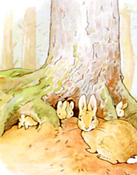
|
Public domain | Public Domain |
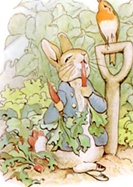
|
Public domain | Public domain |

|
Public domain | Public domain |

|
By User:escritora (Own work) [CC-BY-SA-3.0 (http://creativecommons.org/licenses/by-sa/3.0)], via Wikimedia Commons | http://upload.wikimedia.org/wikipedia/commons/b/b7/Blue_race_car_.jpeg |
